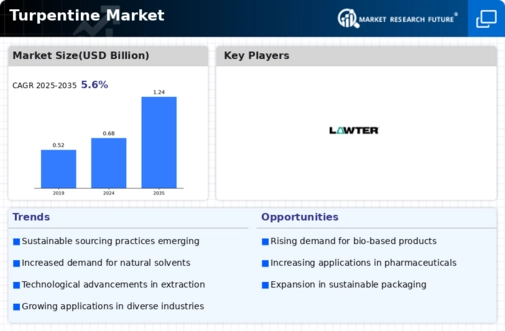Top Industry Leaders in the Turpentine Market

The global turpentine market is expected to reach USD 0.99 billion by 2032, driven by its application in paints & coatings, pharmaceuticals, and cleaning products. However, environmental concerns and volatile raw material prices pose challenges.
Competitive Strategies:
To thrive in this competitive landscape, players are adopting various strategies:
-
Product differentiation: Focusing on high-purity grades, eco-friendly options, and customized solutions for specific applications. -
Geographical expansion: Entering new markets with high growth potential, particularly in developing economies. -
Vertical integration: Securing control over the supply chain to ensure raw material availability and cost optimization. -
Technological advancements: Investing in research and development to improve production efficiency and product quality. -
Strategic partnerships: Collaborating with other companies to expand reach and expertise.
Factors Influencing Market Share:
Several factors influence market share in the turpentine market:
-
Production capacity and efficiency: Players with high production capacity and efficient processes can offer competitive prices and cater to larger demands. -
Quality and consistency: Consistent product quality and purity are crucial factors for customers in various industries. -
Sustainability practices: Increasing environmental awareness drives demand for sustainably sourced and eco-friendly turpentine options. -
Cost competitiveness: Maintaining competitive pricing while ensuring quality is essential for attracting and retaining customers. -
Distribution network: A robust distribution network enables efficient product delivery and market reach.
Key Companies in the Turpentine market include
-
Dujodwala Resins and Terpenes Limited
-
Arakawa Chemical Industries, Ltd.
-
Mentha & Allied Products Pvt. Ltd.
-
Lawter Inc.
-
Harting SpA
-
International Flavors & Fragrances Inc. (IFF)
-
Symrise AG
-
DRT (Dérivés Résiniques et Terpéniques)
-
Georgia-Pacific Chemicals LLC
-
Kraton Corporation
Recent Development
October 2023: Georgia-Pacific Chemicals announces a new partnership with a leading biofuel producer to explore the conversion of turpentine into renewable fuels.
November 2023: The European Union proposes stricter regulations on VOC emissions from paints and coatings, potentially impacting the demand for turpentine-based solvents.
December 2023: The American Society for Testing and Materials (ASTM) revises its standards for turpentine, impacting product specifications and testing protocols.

